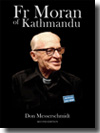| Our Publications | ||
| Books by Title | ||
| Books by Author | ||
| Books by Country | ||
| E-books | ||
| About | ||
| Orchid Press E-books | ||
| Distributed E-books | ||
| Our Bookshop | ||
| About Us | ||
| Browse Shop | ||
| How to Buy | ||
| Contact Us | ||
| WE BUY BOOKS AND LIBRARIES | ||
|
||
Book Reviews

Moran of Kathmandu
Pioneer Priest, Educator and Ham Radio Voice of the Himalaya.
byDonald A. Messerschmidt
2nd ed., 2012, 388 pp., 15 b & w illustrations, index, 23 X 15 cm., softbound.
ISBN-13: 978-974-524-140-4
Moran of Kathmandu
Kumar Pandey (an Electrical Engineer)
(The Kathmandu Post
, June 28, 1998)Reprinted in
The Himalayan Research Bulletin
, Vol. XVIII, No. 1, 1998 &The Nepal Digest July
2nd, 1998Very few people are able to create possibilities and persevere for success in the face of unimaginable odds. Fewer leave behind lasting legacies which future generations will remember and admire. And there are not many with the diversity to be priest, teacher, radio operator, social worker, sports enthusiast and more, in one. Fr. Moran was endowed with all these skills and abilities, and his is a life worth remembering and celebrating.
Donald A. Messerschmidt presents the biography (this could be called an “authorised” biography) of Fr. Marshall D. Moran, SJ in his book Moran of Kathmandu, Priest, Educator and Ham Radio “Voice of the Himalayas.” In sixteen chapters, the book tracks Fr. Moran’s life as a child and student in Chicago, his early adulthood as a novice and junior in Jesuit training schools, his journey to India and, ultimately, his adventures in Nepal. Fr. Moran’s own views on events at various stages of his life are published as “looking back”. Also included are anecdotes of old friends, students and fellow Jesuits who knew Moran. The book further provides some history of missionaries in Nepal over the centuries.
Fr. Moran first came to Nepal in 1949 to administer exams though Patna University, India, at Tri-Chandra College, Kathmandu. It was at that time, during the reign of Mohan Shamsher, that he decided this was where he wanted to work.
There was then only one school in Kathmandu that catered to the upper class and royal household. Few had the courage or interest to establish a modern school in Nepal. Moran had to wait patiently until the ousting of the Ranas to realise this dream. On the afternoon of King Tribhuvan’s return from self-exile in India on 15 February 1951, Marshall received a telegram, “Come at once.” This was indicative of the manner in which Fr. Moran operated. He knew people in high places, sensed forthcoming opportunities and was prepared to take them up as they came.
Fr. Moran had many friends. He made friends as teacher, missionary and ham radio operator. They included royalty, ambassadors, actors and actresses, astronauts, politicians and bureaucrats: people from all walks of life. He came to know many Indian leaders, including Mahatma Gandhi and Jawaharlal Nehru, both of whom he chauffeured in Bihar during India’s fight for independence. He talked to King Mahendra over his radio two times when the latter was travelling abroad. He would also talk to the King of Jordan over his radio, and encountered other famous people of whom most of us would only read about.
Most inspiring of Fr. Moran’s accomplishments, however, is his establishment of several educational and social institutes. Apart from his courage to travel through India on his own (in the 1930s and as a young Jesuit), one admires also the number of institutions he helped set up and operate while there, and later in Nepal. These included the Country School in Bettiah (1930s), St. Xavier’s High School for Boys in Patna (1940), the Women’s College in Patna (1940), Holy Family Hospital in Patna (late l940s), St. Xavier’s Godavari School (1951), St. Xavier’s High School, Jawalakhel (1954), St. Mary’s School for Girls, Jawalakhel, (1955) and the Tibetan Refugee Camp at Jawalakhel (1959-1960). For Fr. Moran, nation-building was about providing disciplined education to young men and women, a true example of investment in indigenous capability building. We oftentimes lament the state of Nepal’s education and the products of our educational system. Perhaps if more of our planners and educators were to internalise Fr. Moran’s vision for the country, we would make more progress.
Fr. Moran, as a Christian priest, had absolute respect for the non-Christian traditions of India and Nepal, which he studied in depth. Fr. Moran shared Mahatma Gandhi’s views on equality of religion and culture. In today’s Nepal, these messages of tolerance and equality are important.
Overall, this book is a worthy token of appreciation for the life and work of Fr. Moran. No book, however, could do entire justice to his achievements. It is not an easy task to bring forth a character so diverse, so intense and driven to achieve the high standards he set for himself. As a former student of Fr. Moran, I read these pages with full admiration for its protagonist, his courage and accomplishments. Fr. Moran’s life should inspire many others. This book is recommended for all planners, educators and pioneers.
[Read a review of the first edition from Radio Society of Great Britain, January 1998] [Read a review of the first edition from The Journal of Contemporary Asia] [More Orchid Press Reviews]
PO Box 70, Trinity TB, NL, A0C 2S0, Canada
Telephone: +1 709-330-4703